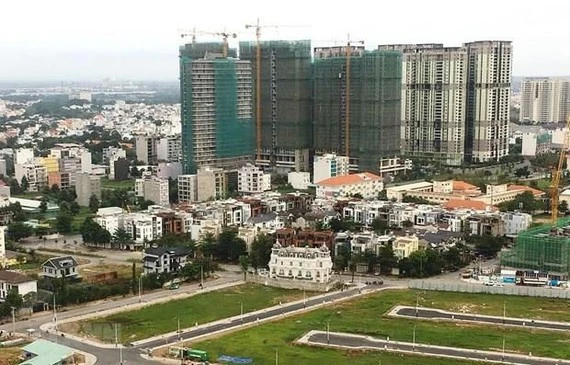
However, most investors still believe that the real estate market in the North has high potential, and the investment flow is expected to be encouraging in the industrial zone segment in the fourth quarter of this year or by next year.
Freeze in market
At the beginning of the year, many experts expected the real estate market in Ha Noi and other provinces in the North to increase by 10-15% in 2019. This expectation was based on the plan to expand and develop the City towards areas in Ha Dong, Gia Lam, and Dong Anh from villages to districts.
The Vietnam Real Estate Association also forecast that the land prices in Ha Noi would increase by 10% in 2019. The prices in the high-end segment and mid and low end segments were expected to rise above 5% and 3-5%, respectively.
Other economists who evaluated Ha Noi and its suburban areas at the beginning phase of the strong development plan, expect the growth of neighboring provinces like Thai Nguyen, Bac Ninh, Bac Giang and Hung Yen to remain stable.
The real estate market in the North is expected to be bogged by many conditions to grow in 2019. The potential is forecast to come from some segments like land plots, townhouses and villas. Note that these segments have been in high demand and gave attractive returns in the past.
However, these were the forecasts. So far, the real estate market in the North has been quiet. Most transactions that have happened in the apartment segment were small scale. There have not been any big projects. There are many reasons to explain this situation, however, the main reason is the tightening of the State Bank on credit flow into the real estate market.
The requirement to reduce the ratio of long term loans to short term deposits from 40% to 30% in 2021-2022 has created pressure for investors to change their investment strategy.
Furthermore, the requirement to increase the risk weighted ratio on the loans, which are above VND 3bn, from 50% to 150% will impact the high-end segment significantly.
Besides, the legal risk is also another issue for the real estate market in the North. Many companies which completed the compensation and land clearance are not able to develop the project because of legal bottlenecks.
According to Nguyen Manh Ha, Chairman of Vietnam Real Estate Association, the above issues are not only problems of the real estate market in the North, but also for whole of Vietnam. 2019 is a complicated year with mixed advantages and challenges. This is the tenth year since the recession of 2008.
Awaiting new opportunities
Some recent forecasts revealed that the real estate market in the North as well as in Vietnam still has much potential to grow, given the investment flow by foreign investors. According to Savills, Vietnam has been a market which attracted foreign investors the most, especially in the industrial zone segment.
The escalating trade war between US and China is expected to bring more opportunities for Vietnam’s real estate market as many companies are moving their plants and offices to Vietnam, a low-risk country.
The cost to construct an office or plant in Vietnam is lower than in China, India or Malaysia. The average labor wage in Vietnam is only USD 237/month while it is USD 412/month in Thailand, USD 866/month in China, and USD 924/month in Malaysia. These two factors will attract investors in considering their new office place.
Furthermore, the FTAs that Vietnam has already signed are also important in attracting new investors. CPTPP and EVFTA will remove 99% of tax barriers, bring more benefit to Vietnamese industries and attract more investors into the industrial zone segment.
The Regional Comprehensive Economic Partnership (RCEP) agreement between ASEAN members and other six countries in the ASIA Pacific Region is expected to be signed by the end of 2019. This will create more opportunities for the Vietnamese real estate market.
Vietnam’s GDP is forecast to grow 6.8% in 2019, the highest growth in the ASEAN region, and an industrial production growth of 9.6% YoY in Q2/2019, which is also a factor that will attract foreign investors.
However, will foreign investment flow into Vietnam as expected? It is an open question. According to John Campbell, an expert in Savills Vietnam, most foreign investors are looking for opportunities in the Central Regions of Vietnam like Hue, Quang Nam and Quang Ngai because of competitive land prices in these areas. Some developers are also considering ways to turn agricultural land to industrial land to supply the high demand expected in the market.




















